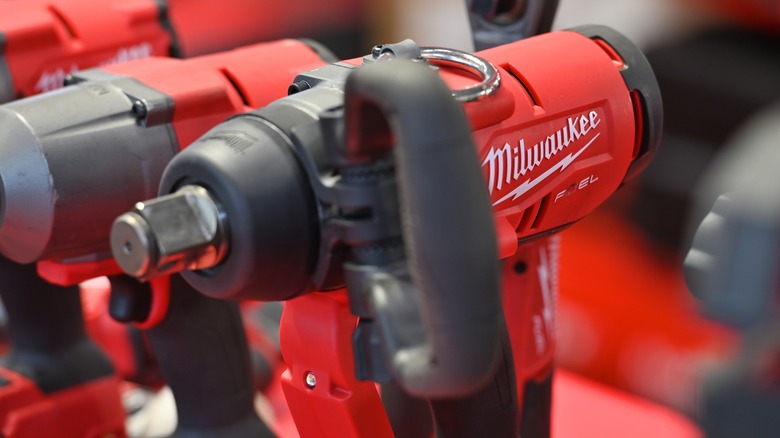
astudio/Shutterstock
By Joe Brown/
Several power tool brands use letters to indicate the technologies used in their products. One example is Makita’s XGT, LXT, and CXT battery systems, which indicates the power level of the batteries. Milwaukee has their own classification to distinguish battery types, split into three categories: CP, XC, and HD. But what’s the difference between each battery type?
Broadly, the CP, XC, and HD classification system does relate to the power level of each battery; however, due to recent developments and new Milwaukee technologies, the battery range can no longer strictly be defined by their power output. Due to the changes, it’s more appropriate to categorize the battery types by their size and weight.
Each battery class can be used with Milwaukee’s M18 tools system, an interchangeable battery system that allows a single battery type to be used among countless 18V power tools. Some of the battery classes also cater to Milwaukee’s M12 cordless lineup, similar to the M18 system but designed for 12V tools.
Like Makita’s battery system, each battery is sized according to the tools they power. CP is the smallest battery class, followed by XC, and finally HD for heavy-duty applications. However, there are some important exceptions to be aware of. If you’re curious to learn the differences between each battery and their potential uses, read on to learn more.
What are Milwaukee’s CP and XC batteries?
Milwaukee’s CP (Compact) and XC (Extended Capacity) classes are the smallest and lightest batteries from the power tools giant. Both the M12 and M18 tools range from Milwaukee have CP and XC batteries.
CP batteries, the smallest of the two, are designed for lightweight tools. Thanks to their compact size and ideal ergonomics, you’ll often use these batteries for jobs where space is limited. The battery’s maximum comfort also helps prevent fatigue when working for extended periods.
The second battery class, XC (Extended Capacity), offers more power and a longer run-time than Milwaukee’s CP batteries. You’ll find them in a wide variety of tools, including drill hammers, circular saws, and jig saws. The batteries are built for a perfect balance between weight and performance for everyday use.
All CP and XC batteries feature Milwaukee’s RedLithium technology, which was announced in 2010. The technology offers longer run time, more power, and the ability to withstand extreme temperatures. You’ll find the RedLithium label on all XC and CP batteries.
What are Milwaukee’s HD batteries?
At the top of its range, Milwaukee’s HD (High Demand) batteries are best suited for heavy-duty work, offering the highest performance levels and longest run time. Unlike Milwaukee’s CP and XC batteries, the HD batteries are exclusive to Milwaukee’s M18 tools system. This doesn’t limit their compatibility, however, as the M18 HD battery will power more than 290 tools in the M18 line. You’ll find HD batteries in sturdy tools which require a long run time, such as string trimmers and rotary hammers.
The first High Demand battery — the Milwaukee M18 HD 9.0Ah battery — was introduced in 2015, setting a new standard for battery performance. At the time of the battery’s release, the HD batteries featured 15 Li-ion cells, while CP and XC batteries contained 5 and 10 cells, respectively.
However, the Milwaukee M18 HD 9.0Ah battery has since been discontinued, and new technologies have changed how CP, XC, and HD batteries are classified. The technologies that reshaped Milwaukee’s battery classification system are known as High Output and Forge.
How do Milwaukee’s High Output and Forge technologies affect the battery classes?
For a long time, the CP, XC, and HD batteries could be defined by their power output. Now, with emerging technologies, this is no longer necessarily the case. Milwaukee’s High Output adaptation was introduced in 2018, offering a significant boost in power and performance to each battery class.
Unlike the prior 18650 RedLithium battery cells, Milwaukee’s High Output batteries feature new and improved 21700 cells for better power, run time, and thermal protection. This technology boost means that a CP High Output 3.0Ah battery can match the performance level of a regular XC 3.0Ah, 4.0Ah, or 5.0Ah battery, thus impacting the battery classification system.
Another technology that has mixed up the CP, XC, and HD classification system is Milwaukee Forge. At the heart of the technology is Milwaukee’s M18 Forge XC 6.0Ah Battery, which has the same power as Milwaukee’s High Output HD 12.0Ah Battery Pack. According to Milwaukee, the battery is 30% smaller and 40% lighter than the High Output HD 12.0Ah Battery, and it can be fully charged in only 25 minutes to minimize wasted time. Both batteries belong to Milwaukee’s Power Level 4 (PWR4), yet they fall into different classes (XC and HD). Overall, the CP, XC, and HD batteries denote the power output available, but there are some notable exceptions to be aware of when it comes to the High Output and Forge versions.